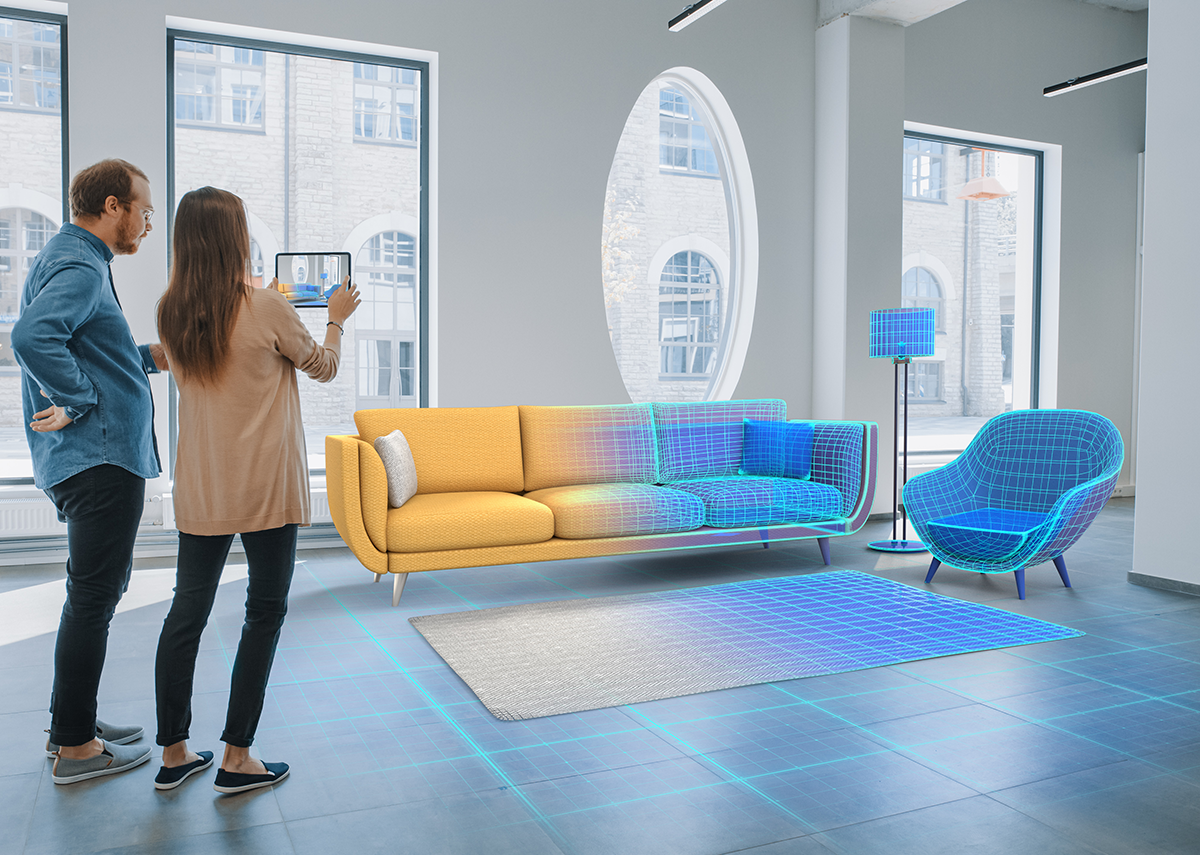
Help, tips & advice: Extended/Augmented Reality gives your marketing an extra boost – Image: Gorodenkoff|Shutterstock.com
Expand and adapt your marketing strategy with Augmented Reality (AR)
"Nothing is as outdated as last year's marketing strategy." This proverb is more relevant than ever in times of digital transformation, because those who rely on outdated marketing methods quickly fall behind their more agile competitors. At the same time, targeted audiences turn away due to a lack of new and engaging entertainment and informational incentives if they are not communicated with via the latest channels and tools.
Therefore, the cross-industry trend towards presenting virtual worlds in marketing continues unabated. No wonder, since 3D animations and videos convey far more than any email newsletter or PDF brochure ever could. Mailings and brochures have long since ceased to merely tease their topics to pique interest and curiosity, ultimately leading to the anticipated landing page. An important component of a correspondingly adapted marketing strategy is augmented reality, which creates a realistic and interactive product experience that leaves a lasting impression on and inspires users.
Augmented Reality has long since outgrown the gaming world
After companies from the gaming and digital sectors were among the pioneers in the use of AR tools, immersive marketing has now gained many followers in traditional manufacturing and industrial sectors. This is quite logical, as the technology allows users to delve much deeper into a brand's content and audiovisually designed worlds, conveying a completely new sense of presence through interactive elements.
AR blurs the lines between reality and virtuality. Since the technology, unlike virtual reality, does not require elaborate glasses, it can also be used in a much broader range of settings – both for physical presentations and purely online.
Augmented Reality is easy to implement and quickly available
What makes AR so interesting for marketing managers in companies is that it's easy to implement with the right software. Service providers like Vuframe GmbH from Regensburg enable their customers to take the uncomplicated step into the brave new virtual world by providing them with powerful systems for transforming their existing CAD and 3D data into the AR environment.
Users can intuitively import their own data directly into the SmartVu platform provided by Vuframe, without requiring any programming knowledge, to design the AR world according to their own wishes. These 3D models can then be easily integrated into app and web content for marketing purposes or made available to the target audience via a link.
Through its powerful compression, Vuframe transforms large datasets into manageable formats. These ensure that the 3D visualizations run smoothly on all devices and systems. The app simulations are designed in such a way that they cannot be reconstructed by third parties, thus guaranteeing the protection of proprietary content at all times.
What was previously only understandable to programmers, unwieldy, large, and impractical to handle manually, is now brought into a compact model thanks to SmartVu, which helps companies create photorealistic AR simulations in a fully automated process in no time at all, which can be used immediately – and the latter is of particular importance in our fast-paced times.
A major advantage of this form of WebAR is its browser-based functionality, eliminating the need for a dedicated app. This allows AR elements to be easily integrated into online campaigns and presented directly to a large target audience. Print campaigns can also be seamlessly integrated with the virtual world. Interested parties can immerse themselves in these virtual environments simply by scanning a QR code embedded in the advertisement. This immediately opens a window to the interactive AR world, enabling users to delve deeply into a company's product offerings from the comfort of their office or even their home. Whether it's the latest sports car or a highly complex industrial plant, AR allows for the creation of virtual environments that perfectly support both B2B and B2C communication for manufacturers and service providers.
Increase interactions with virtual advertising campaigns
The potential applications of AR in marketing are virtually limitless. The technology is ideally suited to conveying the content and emotions of products and brands to the target audience. With the help of appropriate response tools, user interaction can be further enhanced.
Creating virtual showrooms or enhancing physical store presence with AR technology is also possible. All of this is ideally suited to generating greater interest in your products and services among existing and potential customers, and to conveying your brand message in an impressive, engaging, and varied way, thereby strengthening your image in the long term.
Measuring in pocket format
Trade fair solution 4.0 with Pocket Booth – Pocket Booth's innovative app for your pocket makes it easy for companies to implement a digital trade fair presence – Image: Vuframe
The tools described above do not even begin to exhaust the possibilities of AR. This is especially true for trade fairs, which play a crucial role in the marketing strategies of most manufacturers. There, too, virtual experience worlds help companies to inform visitors about their products in a comprehensive and interactive way, and to inspire potential buyers. A good example is the Pocket Booth smartphone app, which brings the trade fair booth to life in a pocket-sized format, regardless of whether the user is physically present at the fair or on the other side of the world.
The app creates elaborately designed 3D simulations, allowing booth staff to present even large systems and machines, which wouldn't fit on a typical exhibition stand, in detail via AR. The same applies to products requiring explanation, which users can explore interactively in a visually unique way within their own company environment.
The virtual world created by Pocket Booth is also ideal for post-show follow-up or remote presentations, as the app functions regardless of time and location. Pocket Booth AR thus offers itself as an ideal complement to the physical trade show booth or even as its virtual replacement – a factor not to be underestimated, especially in times of canceled trade shows, enabling companies to maintain their trade show communication.
Suitable for:
The development has only just begun
However, the methods described do not even begin to exhaust the virtual possibilities of AR. Its almost limitless potential clearly demonstrates that the development of AR has only just begun. Marketing managers should take a close look at the trends to avoid being accused, at the latest next year, of having hopelessly outdated marketing.
More about it here:
3D visualizations: What else could be interesting for you based on the topic!
- No data security: Virtual showrooms & Co. – What most people have forgotten and what you can do about it
- Smartview: Product photo 4.0 / Product image 4.0 – With video and WebAR example!
- Digital Twin – 3D Visualization and Digital Supply Chain Management
- Viewframework – the programming framework for 2022 – including for Product Photo 4.0 and WebAR
Are you looking for strategic advice for your marketing with augmented reality, product photo 4.0 and WebAR solutions? Xpert.Digital supports you!
I would be happy to serve as your personal consultant for augmented reality solutions.
You can contact me by filling out the contact form below or simply call me on +49 89 89 674 804 (Munich) .
I'm looking forward to our joint project.
Xpert.Digital – Konrad Wolfenstein
Xpert.Digital is a hub for industry with a focus on digitalization, mechanical engineering, logistics/intralogistics and photovoltaics.
With our 360° business development solution, we support well-known companies from new business to after sales.
Market intelligence, smarketing, marketing automation, content development, PR, mail campaigns, personalized social media and lead nurturing are part of our digital tools.
You can find out more at: www.xpert.digital – www.xpert.solar – www.xpert.plus

